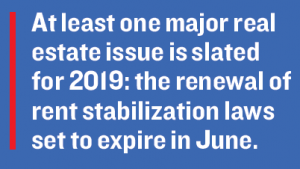Trending
A new Democratic day
What a Senate majority shift in Albany could mean for New York real estate

For just the third time since World War II, the New York State Senate has a Democratic majority. But unlike the two previous times the party briefly took control — in 1965 and 2008 — this new power dynamic potentially poses a big threat to New York real estate due to the wave of overtly anti-industry rhetoric championed by many winning senators.
The 2018 election cycle also saw the demise of several state Democrats with long-standing bipartisan and real estate ties. That shift has industry players swinging wildly between being “nervous,” as public affairs strategist Evan Thies advises they should be, and hearing assurances from the Real Estate Board of New York’s John Banks that “nobody is nervous.”
But apprehension is undeniable considering the number of new senators who crushed their opponents with small donations from individuals — as opposed to the city’s powerful lobby of developers and landlords. Many won over voters by promising to upend the status quo, as political activists targeted some of real estate’s preferred candidates and the industry itself.
After the primaries, newly minted Queens Sen. John Liu wrote in an email that “REBNY is in for a rude awakening,” while veteran Democratic Sen. Brian Kavanagh told The Real Deal to “expect decisive action” on a variety of matters.
New York’s real estate industry reaps tax abatements, subsidies and other political windfalls from the state’s current laws, all of which could, in theory, be altered in a changing of the guard in Albany. The 40-23 majority for Senate Democrats marks a “decidedly strong shift left, with [eight] seats flipping,” Thies said.
The presidential aspirations of Gov. Andrew Cuomo and questions about how many Senate Democrats will stay “true blue” and not vote with their Republican colleagues complicates the new political landscape. As noted in TRD’s October cover story, splinter groups and new allegiances have long been key parts of the Albany machine, and it’s unclear whether factionalism has suddenly become a thing of the past.
Here’s what you need to know about the new Senate majority, key political power brokers, the items on their agenda and what it all means for New York real estate.
Democratic déjà vu
When Democrats previously took control of the Senate, their majority was slim and quickly dissolved. Those victories often saw elected Democrats such as the Independent Democratic Conference — a group of eight rogue senators that dissolved in April — align themselves with pro-business Republicans. 
Brooklyn Democrat Simcha Felder, who has long caucused with the GOP, was re-elected in November but now holds less influence since his vote is no longer decisive. (Republicans held the balance of power despite the Democrats’ technical 32-31 majority due to Felder’s vote, but Democrats now control the chamber by a significant margin regardless of his position.)
Bill Samuels, founder of watchdog group EffectiveNY, attributed the last true Democratic majority’s loss a decade ago to a “crazy leadership group.” He described the current Senate leadership as “very mature” and said the real estate industry shouldn’t feel “cause for worry.”
“They’ll get a fair hearing,” Samuels said. “There will be change. I’m just saying that it’s not going to be radical change.”
Thies echoed that point. “Democrats are aware that the last time they were in power… they moved too quickly on a number of liberal agenda items,” he said, noting that within a year of its 2008 victory the party lost senators representing more conservative, suburban districts because they went for “big policy swings.”
A decade later, Thies doesn’t expect a similar approach, noting that housing and property issues will likely remain in the background until budget negotiations begin.
Legislative and legal wranglings
At least one major real estate issue is slated for 2019: the renewal of rent stabilization laws set to expire in June. Rent-stabilized apartments are units with a monthly rent of less than $2,733.75. State law governs the amount by which landlords can increase rent for stabilized units upon lease renewal or a vacancy. Destabilization, or vacancy decontrol, occurs after extensive renovations or once annual increases push apartments past the monthly rent threshold.
Developers have been accused of gaming vacancy decontrol and tax abatement rules, which could provide rhetorical fire for lawmakers eager to point out bad real estate actors. The New York Times reported in October that the late Fred Trump systematically inflated capital improvement bills on his buildings in order to raise rents on his stabilized properties.
In August, Kushner Companies was fined $210,000 for falsifying building permits to omit rent-stabilized units, and a TRD investigation found that the company was one of several landlords — including the Blackstone Group, LeFrak Organization and Malek Management — to file incorrect paperwork that left out any mention of stabilized units.
A slew of other reform legislation has also been proposed and remains pending, which many pro-tenant lawyers, advocates and voters appear eager to see revived. Though members of New York’s Housing, Construction and Community Development Committee have yet to be selected, Kavanagh vowed that there will be a strong effort to start a new chapter. “We’re going to have new conversations with the various players in the industry,” he said.
There’s also the matter of the Urstadt Law, which keeps rent regulation under the thumb of the Senate and which some progressives have vowed to repeal over the years. Democratic Sen. Elizabeth Krueger sought to do so in 2017, but it remains a contentious issue for the new majority and housing advocates. Sam Himmelstein, a tenant attorney with New York’s Himmelstein, McConnell, Gribben, Donoghue & Joseph, predicted that any repeal effort will fall “by the wayside” as Democrats launch a statewide push for counties outside the city to adopt rent regulation.
Finally, bills to change spending rules that allow LLCs to be used to contribute virtually unlimited sums to political campaigns have a fighting chance of passing after years of stagnation. Increased transparency eliminating such loopholes could significantly curb REBNY and other real estate lobbyists’ efforts to influence candidates for public office.
Presidential wild card
Cuomo’s ambitions for higher office are muddying the waters for Albany strategists and members of his own party. Cuomo is now in his third term, and no other candidate for governor in New York has received more support from the real estate sector. But a presidential campaign could lead Cuomo to stray from old real estate friends if he wants a showdown with President Donald Trump in 2020.
Cuomo’s recent gubernatorial campaign seemed like a trial run for the presidency, said political strategist Basil Smikle, an executive director of the New York State Democratic Party.
“He ran against Trump,” Smikle said of Cuomo, who raised nearly $35.7 million for the 2018 election cycle with real estate making up the top industry backing the governor. “He’s trying to achieve some sort of national platform as one of the governors unafraid to stand up to the president.” Smikle noted that any presidential candidate will likely announce their intentions this spring.
Cuomo shifted many of his positions to the left during his primary battle with challenger Cynthia Nixon. After November’s election, Cuomo publicly pledged to end vacancy decontrol.
Thies, the political strategist, said that while the real estate sector can still count on Cuomo’s ongoing support, it should expect the governor “to be a shield but not a sword.”




